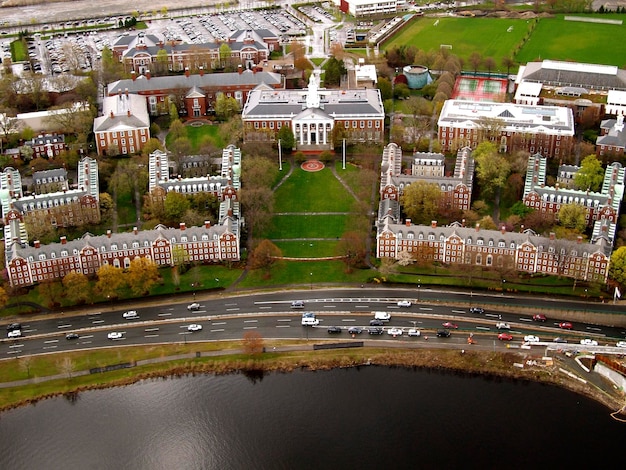Public vs Private Universities: Key Differences for US Students

The key differences between public and private universities in the US lie in their funding sources, tuition costs, and often, campus culture, with public universities generally receiving state funding and offering lower tuition for in-state residents.
Choosing the right university is a pivotal decision, shaping your academic and professional future. Understanding what are the key differences between public and private universities in the US is crucial for making an informed choice. This guide breaks down the distinctions to help you find the perfect fit.
Understanding the Basics of Public vs. Private Universities
Public and private universities both offer valuable higher education opportunities, but they operate under different structures. Understanding these foundational differences is essential for prospective students.
Funding and Governance
Public universities receive funding primarily from state governments, which allows them to offer lower tuition rates, especially for in-state residents. They are governed by boards appointed by the state.
Private universities, however, rely on tuition fees, endowments, and private donations. They are governed by a board of trustees and often have more autonomy in their operations.
- 💰 Funding Sources: Public universities depend on state funding, while private universities rely on tuition, endowments, and donations.
- 🏛️ Governance: Public universities are governed by state-appointed boards, whereas private universities have independent boards of trustees.
- 💲 Tuition Costs: Public universities generally offer lower tuition for in-state residents, while private universities tend to have higher, more uniform tuition rates.
- 🏛️ Mission and Focus: Public universities often have a broader mission to serve the public good, while private universities may have specific focuses or affiliations.
In summary, the core distinction lies in how these institutions are funded and governed, which significantly impacts tuition costs and the overall mission of the university.
Tuition and Financial Aid Opportunities
One of the most significant factors in choosing between a public and private university is the cost. The financial aid opportunities, however, can balance the scales.
The Cost Factor
Public universities typically offer lower tuition for in-state students due to state subsidies. Out-of-state tuition at public universities is usually higher but still often lower than private university tuition.
Private universities generally have higher tuition rates, but they also tend to offer more generous financial aid packages and scholarships.

Navigating Financial Aid
Exploring financial aid options is crucial. Public universities offer state-funded grants and federal aid, while private universities often have larger endowments to provide need-based and merit-based scholarships.
Students should research all available aid, including grants, scholarships, loans, and work-study programs, to make an informed financial decision.
Ultimately, while the sticker price of private universities can be intimidating, the financial aid packages available can often make them comparable in cost to public institutions, depending on individual circumstances.
Academic Programs and Resources
Academic programs and available resources are critical factors when selecting a university. Both public and private institutions offer diverse opportunities, but with different emphases.
Breadth vs. Specialization
Public universities often provide a wider range of academic programs, catering to diverse interests and career paths. They tend to have extensive departments and research facilities.
Private universities may focus on specific areas of academic excellence, such as liberal arts, engineering, or business, offering specialized programs and personalized attention.
Resources and Facilities
Public universities often have extensive libraries, research labs, and athletic facilities due to their larger size and state funding. These resources support a broad range of academic and extracurricular activities.
Private universities, while potentially smaller, often invest heavily in cutting-edge technology and personalized learning environments. This investment can enhance the student experience despite a smaller scale.
In short, public universities frequently offer a broader range of programs and resources, while private universities may provide more specialized and personalized academic experiences.
Campus Culture and Student Life
The campus culture and student life at a university significantly impact the overall college experience. Public and private universities foster distinct atmospheres.

Diversity and Community
Public universities often boast a more diverse student body due to their accessibility and broader mission. This diversity enriches the campus environment and promotes cultural exchange.
Private universities may have a more homogenous student population, reflecting their specific missions or selective admissions processes. However, they often foster tight-knit communities through smaller class sizes and niche activities.
Extracurricular Activities
Public universities typically offer a wide array of extracurricular activities, from sports teams to student organizations. Large student bodies support a range of interests and pursuits.
Private universities may have fewer extracurricular options but often provide more personalized attention and leadership opportunities within those activities. Smaller groups allow for more active participation.
In essence, public universities are known for their diversity and abundant extracurricular choices, while private universities often provide more intimate and focused campus experiences.
Career Opportunities and Alumni Networks
The career opportunities available after graduation and the strength of the alumni network are important considerations. Both types of universities offer unique advantages.
Industry Connections
Public universities often have strong ties to local industries and government agencies, providing students with internships and job opportunities in their state or region.
Private universities may have broader national and international connections, offering students access to a wider range of career paths and global opportunities.
Alumni Engagement
Public university alumni networks can be vast, particularly within the state. This extensive network may provide valuable local connections for graduates.
Private university alumni networks tend to be smaller but often more tightly knit. This can result in more personalized mentorships and career support.
Ultimately, the choice depends on the student’s career aspirations: public universities offering strong local ties, and private universities providing wider-reaching connections.
Admission Requirements and Selectivity
Admission requirements and selectivity differ significantly between public and private universities, affecting the applicant pool and academic standards.
Application Process
Public universities often have more standardized admission criteria, focusing on GPA, standardized test scores, and residency status. The application process may be more streamlined and less holistic.
Private universities typically employ a more holistic admission process, considering essays, extracurricular activities, letters of recommendation, and demonstrated passion alongside academic metrics.
Acceptance Rates
Public universities generally have higher acceptance rates, particularly for in-state applicants, due to their mission to serve the broader population.
Private universities often have lower acceptance rates, especially the highly selective institutions. This selectivity can lead to a more academically focused and competitive environment.
In conclusion, public universities may offer a more accessible path to admission, while private universities emphasize a more comprehensive evaluation of applicants.
| Key Aspect | Brief Description |
|---|---|
| 💰 Tuition Fees | Public: Lower for in-state residents. Private: Generally higher, but more aid available. |
| 🏛️ Governance | Public: State-controlled. Private: Independent board of trustees. |
| 🧑🎓 Student Body | Public: More diverse. Private: Potentially more homogenous, but tight-knit. |
| 🏫 Programs | Public: Broader range. Private: Specialized, with personalized attention. |
Frequently Asked Questions
▼
Not necessarily. Both public and private universities can offer excellent education. Quality depends more on the specific program and faculty than the type of institution.
▼
While the sticker price is often higher, private universities frequently offer more generous financial aid packages, potentially making the net cost comparable to public institutions.
▼
Both can offer research opportunities. Public universities often have extensive facilities, while private universities might provide more personalized research mentorship.
▼
Some do, while others are secular. It’s important to research the specific institution’s mission and values to see if they align with your own.
▼
Consider your budget, academic interests, desired campus culture, and career goals. Visit campuses, talk to students, and research programs to find the best fit.
Conclusion
Understanding what are the key differences between public and private universities in the US is a significant step toward making an informed decision. Weigh your priorities, research your options, and visit campuses to find the university that best aligns with your academic and personal aspirations.





